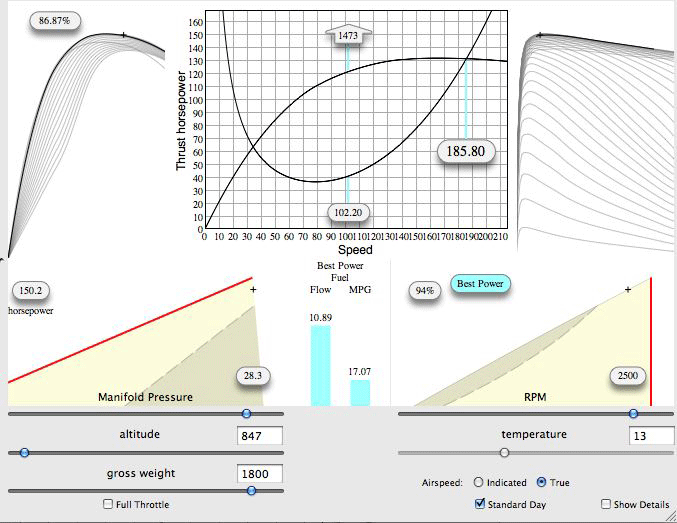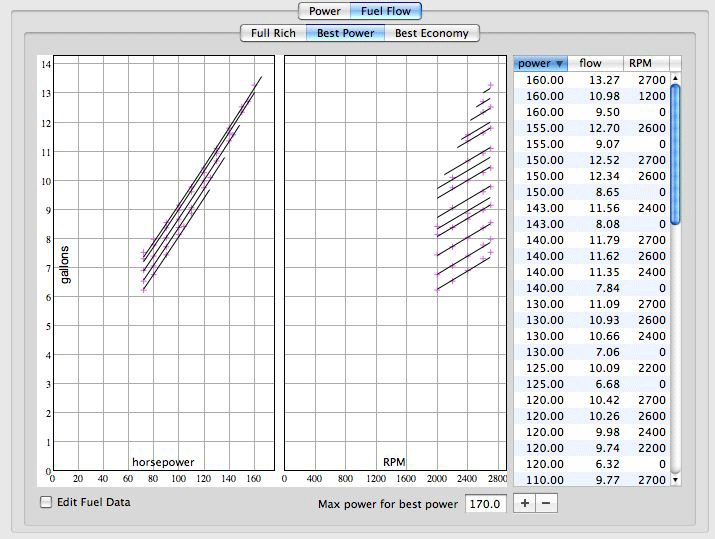Computer Aided Flight Testing Comes to General Aviation
![]()
Computer Aided Flight Testing Comes to General Aviation |
|
by Kas Thomas
A couple years ago, we mentioned that people are constantly asking us if there isn't some easy way to calculate engine power (from a simple formula), given manifold pressure, prop rpm, and fuel flow. Alfred Scott of Sequoia Aircraft was quick to offer up the proper polynomials to fit existing engine handbook data with "percent power'' curves (and we printed the somewhat daunting equations in our May '88 issue, p. 9). Still, questions of how to calculate changes in power (or airspeed) based on changes in manifold pressure, rpm, OAT, etc. are enormously important to some people-CAFE racers, aircraft designers, people going for record attempts-and the idea of doing a lot of polynomial crunching on a scientific calculator (just to get a few answers to a few simple questions) leaves one wishing someone would come up with an easier way. Someone did. Alfred Scott plugged his polynomials—and a lot more—into his Macintosh computer, and now (many thousands of lines of Pascal code later) the results of his Herculean programming effort are ready to be marketed in a standalone application dubbed, simply, "Benchmark." Benchmark is kind of hard to describe; it's a Swiss army knife kind of program, containing within it many powerful number crunching engines, including a nifty atmospherics calculator (which will calculate all the traditional pressure, temperature, and density numbers for all altitudes, along with true airspeed, Mach numbers, ram rise, etc.) and a prop-efficiency calculator which plots propeller efficiency at various speeds, altitudes, and power settings. But the overall purpose of Benchmark is to automate the heretofore excruciating process of flight test data reduction. The accompanying graphs should begin to give you some of the flavor of this. In a nutshell: If you've got the data points, Benchmark's got the answers to whatever performance-related questions are nagging you. For engine power curves, Benchmark simply starts with the engine manufacturer's sea-level performance data, then back-fits curves to these data points; ditto for fuel-flow data. Once these curves are generated, Benchmark can calculate (at the press of a button) engine power or fuel consumption or miles-per-gallon at any pressure, temperature, MP, and rpm. |

Benchmark's speed calculator shows a plot of power required and power available as well as the rate of climb and fuel flow (speed is plotted on the x-axis; true-horsepower on the y-axis). Full throttle means the manifold pressure is calculated at each speed for the indiction system ram recovery. If you're worried about instrumentation error, Benchmark will guide you through the entry of pitot-static flight test data, fitting curves to the points automatically. Even induction system ram recovery is handled (and of course, all airplane performance numbers generated by the program change as aircraft weight changes). The aircraft speed calculator (which generates power required and power available curves versus speed) relies on two "magic numbers," called Cdo and Oswald E, which the program will generate for your airplane when you enter actual flight test data at various power settings. Once Cdo and Oswald E are available, you can generate any number of interesting (bordering on downright unbelievable) graphs and charts, including CAFE score versus airspeed versus percent power, or miles-per-gallon vs. TAS, etc. This is where the program really shines, because what you're looking at here is graphical engineering data for your airplane—not an "average production aircraft." |

Curve-fitting the best power fuel data of a Lycoming IO-320-B1A Benchmark is an impressive programming effort, but not without its limitations. The foremost limitation, of course, is that you have to own a Macintosh computer. Another limitation is that the program doesn't acknowledge the existence of fixed-pitch propellers (all calculations assume a constant-speed prop), although thankfully, it does accommodate turbocharged and/or twin-engined airplanes. If you're serious about wanting accurate performance charts for your airplane (in far greater variety than those found in your POH), Benchmark is a must-have program. For some people, in fact, it will justify the purchase of a Macintosh. |
|
|